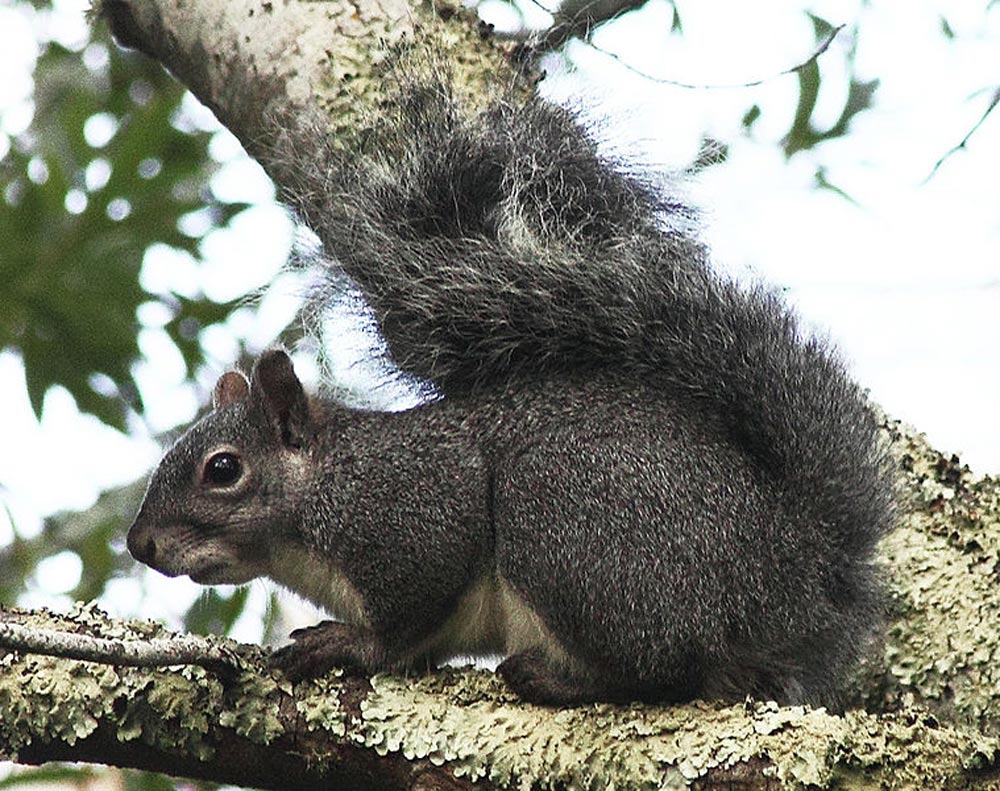Protecting the Western Gray Squirrel: A Case for Endangered Species Act Protections
Matthew Russell
In the serene landscapes of Washington state, amidst the lush forests and tranquil natural beauty, an iconic resident is silently struggling for survival. The Western gray squirrel, once a symbol of the region's thriving ecosystem, is facing a perilous decline.
Regional reports show their numbers dwindling and their habitats shrinking. The question arises: Can we save this remarkable creature from the brink of extinction?
Considering the threats faced by the Western gray squirrel, extending protections of the Endangered Species Act to this unique species could provide some much needed defense.
 Photo: Wikimedia Commons / Julielynns, License: CC BY-SA 4.0 DEED
Photo: Wikimedia Commons / Julielynns, License: CC BY-SA 4.0 DEEDThe Western Gray Squirrel is native to Washington state.
A Precarious Existence
The Western gray squirrel, known for its distinctive gun-metal gray fur and imposing size, is an integral part of Washington's biodiversity. Historically, these magnificent tree squirrels inhabited low- to mid-elevation forests adorned with oaks, pines, and Douglas firs. However, the landscape that once thrived with these elegant creatures is now marred by a stark decline in their numbers.
One of the primary threats to these squirrels is the diminishing habitat, maintains Washington's Department of Fish and Wildlife (WDFW). Factors such as timber harvests, wildfires, land conversion, and climate change have drastically altered their natural surroundings.
"Catastrophic wildfires really reduced their habitat in that part of the state (Chelan and Okanogan Counties) by around 20%," Taylor Cotten with the Washington Department of Fish and Wildlife told KPQ. "In the southern part of the (Cascade) range and the Klickitat, Yakima areas, it's more towards timber extraction and logging and that's primarily the reason we're seeing a loss around 20% of habitat."
As the lush forests they call home transform, these creatures find themselves navigating an ever-shrinking territory.
 Photo: Wikimedia Commons / The wu zetian, License: CC BY-SA 4.0 DEED
Photo: Wikimedia Commons / The wu zetian, License: CC BY-SA 4.0 DEEDThe Western gray squirrel inhabits low- to mid-elevation forests in Washington.
The Critical Role of the Western Gray Squirrel
Beyond their aesthetic appeal, Western gray squirrels play a pivotal role in their ecosystem. According to the Pacific Biodiversity Institute, their unique foraging habits facilitate the dispersion of truffle spores that attach to tree roots. This seemingly simple act has profound ecological consequences, as it enables trees to absorb vital water and nutrients from the soil. In essence, these squirrels contribute to the health and vitality of the forests they inhabit.
Despite their ecological importance, these majestic creatures face numerous challenges, including predation by other wildlife. iNaturalist, maintains house cats are some of the squirrel's major predators, while traffic mortalities contribute to further decline. The circle of life can be harsh, and the Western gray squirrel often falls prey to animals higher up the food chain. Nevertheless, their survival is not just a matter of biology; it is also a testament to the resilience of a species.
The Urgent Need for Endangered Species Act Protections
Recognizing the severity of the situation the WDFW has taken a proactive stance. They are advocating for the reclassification of the Western gray squirrel from "threatened" to "endangered" status. This change would usher in a range of protective measures aimed at conserving the species, including stricter penalties for harming or killing them.
 Photo: WesternGraySquirrel1, Wikimedia Commons / Fish Demon, License: CC BY-SA 3.0 DEED
Photo: WesternGraySquirrel1, Wikimedia Commons / Fish Demon, License: CC BY-SA 3.0 DEEDDeclining habitat is a major threat to the survival of this species.
The Population Conundrum
As of the most recent estimates, the Western gray squirrel population in Washington stands somewhere between 468 and 1,405 individuals, KIRO TV reports. These squirrels are dispersed across three regions: the Puget Trough, Klickitat, and Okanogan. However, none of these populations appear large enough to prevent a decline in genetic diversity, and some may already be suffering from the negative effects of inbreeding. This alarming situation emphasizes the urgency of conservation efforts.
Eastern vs. Western: A Case of Mistaken Identity
A common challenge faced in the conservation of Western gray squirrels is the presence of their non-native counterpart, the Eastern gray squirrel. Introduced to Washington in the early 1900s, Eastern gray squirrels are now a common sight in urban areas, reports Life in the City. Their resemblance to the threatened Western gray squirrel can lead to confusion and potential misidentification, making conservation efforts more challenging.
 Photo: Wikimedia Commons / Alan Schmierer, License: CC0 1.0 DEED
Photo: Wikimedia Commons / Alan Schmierer, License: CC0 1.0 DEEDWashington's Department of Fish and Wildlife is considering upgrading their status from "threatened" to "endangered."
A Beacon of Hope
While the road ahead may be arduous, there is hope for the Western gray squirrel. Extending Endangered Species Act protections to this species could mark a turning point in its conservation journey. Higher penalties for harming or killing these squirrels would act as a deterrent, offering them a chance to recover and thrive once again.
The plight of the Western gray squirrel serves as a stark reminder of the delicate balance of nature and the far-reaching consequences of human actions.
The Western gray squirrel's future hangs in the balance, and it's up to us to ensure that this iconic species continues to grace our forests for generations to come.
Click below and sign the petition to save the Western gray squirrel
Matthew Russell is a West Michigan native and with a background in journalism, data analysis, cartography and design thinking. He likes to learn new things and solve old problems whenever possible, and enjoys bicycling, spending time with his daughters, and coffee.




















